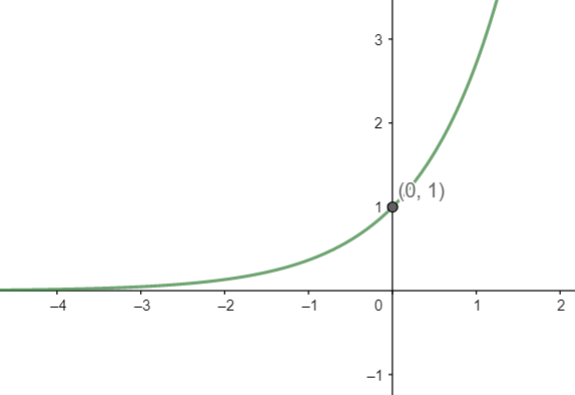
If $A=\left\{ \left( x,y \right):y={{e}^{x}},x\in R \right\}$ and $B=\left\{ \left( x,y \right):y={{e}^{-x}},x\in R \right\}$, then write $A\cap B$.
Answer
595.5k+ views
Hint:To solve this question, we will first convert both the given sets from set builder form to the roster form and then we will find all the possible values of A that will be equal to B. Also, we should know that we will get the values of A and B by putting different values of x and y.
Complete step-by-step answer:
In this question, we have been given that, $A=\left\{ \left( x,y \right):y={{e}^{x}},x\in R \right\}$ and$B=\left\{ \left( x,y \right):y={{e}^{-x}},x\in R \right\}$ and we have been asked to find the value of $A\cap B$. Now, let us consider R, that is real numbers as a group of ${{R}^{+}}$ (positive real numbers), and ${{R}^{-}}$ (negative real numbers). So, we get,
$A=\left\{ \left( x,y \right):y={{e}^{x}},x\in {{R}^{-}} \right\}+\left\{ \left( x,y \right):y={{e}^{+x}},x=0 \right\}+\left\{ \left( x,y \right):y={{e}^{x}},x\in {{R}^{+}} \right\}$
$B=\left\{ \left( x,y \right):y={{e}^{-x}},x\in {{R}^{-}} \right\}+\left\{ \left( x,y \right):y={{e}^{-x}},x=0 \right\}+\left\{ \left( x,y \right):y={{e}^{-x}},x\in {{R}^{+}} \right\}$
And if we put the values of $x$ as ${{R}^{-}},0,{{R}^{+}}$, we get,
$A=\left\{ \left( {{R}^{-}},{{e}^{R-}} \right),\left( 0,{{e}^{0}} \right),\left( {{R}^{+}},{{e}^{R+}} \right) \right\}$ and
$B=\left\{ \left( {{R}^{-}},{{e}^{-R-}} \right),\left( 0,{{e}^{-0}} \right),\left( {{R}^{+}},{{e}^{-R+}} \right) \right\}$.
Since, we know that any term raised to 0 is 1, we have ${{e}^{0}}=1$. So, simplifying the above, we get,
$A=\left\{ \left( {{R}^{-}},{{e}^{R-}} \right),\left( 0,1 \right),\left( {{R}^{+}},{{e}^{R+}} \right) \right\}$
$B=\left\{ \left( {{R}^{-}},{{e}^{R+}} \right),\left( 0,1 \right),\left( {{R}^{+}},{{e}^{R-}} \right) \right\}$
Here, we have written $-{{R}^{-}}$ as $+{{R}^{+}}$ because negative real numbers are multiplication of negative 1 and positive real numbers. Now, if we consider both A and B, we can say that (0, 1) is the only value which is present in both the sets. So, we can say $A\cap B=\left\{ \left( 0,1 \right) \right\}$.
Hence, we can say if $A=\left\{ \left( x,y \right):y={{e}^{x}},x\in R \right\}$ and $B=\left\{ \left( x,y \right):y={{e}^{-x}},x\in R \right\}$, then $A\cap B=\left\{ \left( 0,1 \right) \right\}$.
Note: The possible mistakes one can make is that in a hurry, one can assume $y={{e}^{x}}$ in set B, which would result in a wrong answer. We can also solve this question by considering the graphs of both $y={{e}^{x}}$ and $y={{e}^{-x}}$, that are: $y={{e}^{x}}$can be represented as below,

And $y={{e}^{-x}}$ can be represented as,

From both the curves, we can see that they will possibly intersect at (0, 1). So, we can write, $A\cap B=\left\{ \left( 0,1 \right) \right\}$.
Complete step-by-step answer:
In this question, we have been given that, $A=\left\{ \left( x,y \right):y={{e}^{x}},x\in R \right\}$ and$B=\left\{ \left( x,y \right):y={{e}^{-x}},x\in R \right\}$ and we have been asked to find the value of $A\cap B$. Now, let us consider R, that is real numbers as a group of ${{R}^{+}}$ (positive real numbers), and ${{R}^{-}}$ (negative real numbers). So, we get,
$A=\left\{ \left( x,y \right):y={{e}^{x}},x\in {{R}^{-}} \right\}+\left\{ \left( x,y \right):y={{e}^{+x}},x=0 \right\}+\left\{ \left( x,y \right):y={{e}^{x}},x\in {{R}^{+}} \right\}$
$B=\left\{ \left( x,y \right):y={{e}^{-x}},x\in {{R}^{-}} \right\}+\left\{ \left( x,y \right):y={{e}^{-x}},x=0 \right\}+\left\{ \left( x,y \right):y={{e}^{-x}},x\in {{R}^{+}} \right\}$
And if we put the values of $x$ as ${{R}^{-}},0,{{R}^{+}}$, we get,
$A=\left\{ \left( {{R}^{-}},{{e}^{R-}} \right),\left( 0,{{e}^{0}} \right),\left( {{R}^{+}},{{e}^{R+}} \right) \right\}$ and
$B=\left\{ \left( {{R}^{-}},{{e}^{-R-}} \right),\left( 0,{{e}^{-0}} \right),\left( {{R}^{+}},{{e}^{-R+}} \right) \right\}$.
Since, we know that any term raised to 0 is 1, we have ${{e}^{0}}=1$. So, simplifying the above, we get,
$A=\left\{ \left( {{R}^{-}},{{e}^{R-}} \right),\left( 0,1 \right),\left( {{R}^{+}},{{e}^{R+}} \right) \right\}$
$B=\left\{ \left( {{R}^{-}},{{e}^{R+}} \right),\left( 0,1 \right),\left( {{R}^{+}},{{e}^{R-}} \right) \right\}$
Here, we have written $-{{R}^{-}}$ as $+{{R}^{+}}$ because negative real numbers are multiplication of negative 1 and positive real numbers. Now, if we consider both A and B, we can say that (0, 1) is the only value which is present in both the sets. So, we can say $A\cap B=\left\{ \left( 0,1 \right) \right\}$.
Hence, we can say if $A=\left\{ \left( x,y \right):y={{e}^{x}},x\in R \right\}$ and $B=\left\{ \left( x,y \right):y={{e}^{-x}},x\in R \right\}$, then $A\cap B=\left\{ \left( 0,1 \right) \right\}$.
Note: The possible mistakes one can make is that in a hurry, one can assume $y={{e}^{x}}$ in set B, which would result in a wrong answer. We can also solve this question by considering the graphs of both $y={{e}^{x}}$ and $y={{e}^{-x}}$, that are: $y={{e}^{x}}$can be represented as below,

And $y={{e}^{-x}}$ can be represented as,

From both the curves, we can see that they will possibly intersect at (0, 1). So, we can write, $A\cap B=\left\{ \left( 0,1 \right) \right\}$.
Recently Updated Pages
Master Class 11 Business Studies: Engaging Questions & Answers for Success

Master Class 11 Computer Science: Engaging Questions & Answers for Success

Master Class 11 Maths: Engaging Questions & Answers for Success

Master Class 11 Chemistry: Engaging Questions & Answers for Success

Master Class 11 Economics: Engaging Questions & Answers for Success

Master Class 11 Accountancy: Engaging Questions & Answers for Success

Trending doubts
What is meant by exothermic and endothermic reactions class 11 chemistry CBSE

10 examples of friction in our daily life

One Metric ton is equal to kg A 10000 B 1000 C 100 class 11 physics CBSE

1 Quintal is equal to a 110 kg b 10 kg c 100kg d 1000 class 11 physics CBSE

Difference Between Prokaryotic Cells and Eukaryotic Cells

What are Quantum numbers Explain the quantum number class 11 chemistry CBSE




